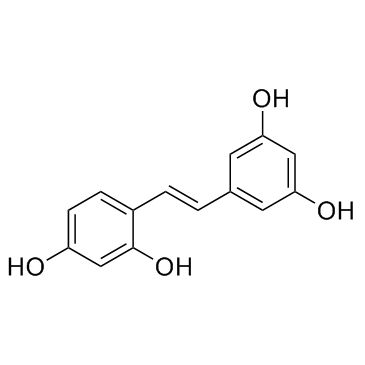Oxyresveratrol
Modify Date: 2025-08-21 16:05:57

Oxyresveratrol structure
|
Common Name | Oxyresveratrol | ||
|---|---|---|---|---|
| CAS Number | 29700-22-9 | Molecular Weight | 244.243 | |
| Density | 1.5±0.1 g/cm3 | Boiling Point | 523.8±30.0 °C at 760 mmHg | |
| Molecular Formula | C14H12O4 | Melting Point | 201ºC | |
| MSDS | N/A | Flash Point | 260.8±19.2 °C | |
Use of OxyresveratrolOxyresveratrol is neuroprotective and inhibits the apoptotic cell death in transient cerebral ischemia. It effectively scavenges H2O2, NO (IC50 = 45.3 μM), and the artificial free radical 2,2-diphenyl-l-picrylhydrazyl (IC50 = 28.9 μM) In vitro: 1)oxyresveratrol exhibited more than 50% inhibition at 100 μM on L-tyrosine oxidation by murine tyrosinase activity.2) oxyresveratrol showed an IC50 value of 52.7 μM on the enzyme activity. 3) oxyresveratrol works through reversible inhibition of tyrosinase activity rather than suppression of the expression and synthesis of the enzyme.[2] In vivo: 1) Oxyresveratrol (10 or 20 mg/kg) significantly reduced the brain infarct volume by approximately 54% and 63%, respectively, when compared to vehicle-treated MCAO rats.2) oxyresveratrol treatment diminished cytochrome c release and decreasedcaspase-3 activation in MCAO rats. [3] |
| Name | 4-[(E)-2-(3,5-dihydroxyphenyl)ethenyl]benzene-1,3-diol |
|---|---|
| Synonym | More Synonyms |
| Description | Oxyresveratrol is neuroprotective and inhibits the apoptotic cell death in transient cerebral ischemia. It effectively scavenges H2O2, NO (IC50 = 45.3 μM), and the artificial free radical 2,2-diphenyl-l-picrylhydrazyl (IC50 = 28.9 μM) In vitro: 1)oxyresveratrol exhibited more than 50% inhibition at 100 μM on L-tyrosine oxidation by murine tyrosinase activity.2) oxyresveratrol showed an IC50 value of 52.7 μM on the enzyme activity. 3) oxyresveratrol works through reversible inhibition of tyrosinase activity rather than suppression of the expression and synthesis of the enzyme.[2] In vivo: 1) Oxyresveratrol (10 or 20 mg/kg) significantly reduced the brain infarct volume by approximately 54% and 63%, respectively, when compared to vehicle-treated MCAO rats.2) oxyresveratrol treatment diminished cytochrome c release and decreasedcaspase-3 activation in MCAO rats. [3] |
|---|---|
| Related Catalog | |
| References |
| Density | 1.5±0.1 g/cm3 |
|---|---|
| Boiling Point | 523.8±30.0 °C at 760 mmHg |
| Melting Point | 201ºC |
| Molecular Formula | C14H12O4 |
| Molecular Weight | 244.243 |
| Flash Point | 260.8±19.2 °C |
| Exact Mass | 244.073563 |
| PSA | 80.92000 |
| LogP | 3.17 |
| Vapour Pressure | 0.0±1.4 mmHg at 25°C |
| Index of Refraction | 1.801 |
| 4-[(E)-2-(3,5-Dihydroxyphenyl)ethenyl]benzene-1,3-diol |
| Puag-haad |
| 2,4,3',5'-Tetrahydroxystilbene |
| 3,4,3',5'-tetrahydroxy-trans-stilbene |
| OXYLRESVERATROL |
| trans-oxyresveratrol |
| 2,3',4,5'-Tetrahydroxy-trans-stilbene |
| (E)-4-(3,5-Dihydroxystyryl)benzene-1,3-diol |
| Oxyresveratrol |
| 1,3-Benzenediol, 4-(2-(3,5-dihydroxyphenyl)ethenyl)-, (E)- |
| EINECS 300-008-4 |
| 2,3',4,5'-Tetrahydroxystilbene |
| 4-[(E)-2-(3,5-Dihydroxyphenyl)vinyl]-1,3-benzenediol |
| trans-2,3',4,5'-tetrahydroxystilbene |
| 4-[(E)-2-(3,5-Dihydroxyphenyl)vinyl]benzene-1,3-diol |
| 1,3-Benzenediol, 4-(2-(3,5-dihydroxyphenyl)ethenyl)- |
| 1,3-Benzenediol, 4-[(E)-2-(3,5-dihydroxyphenyl)ethenyl]- |

